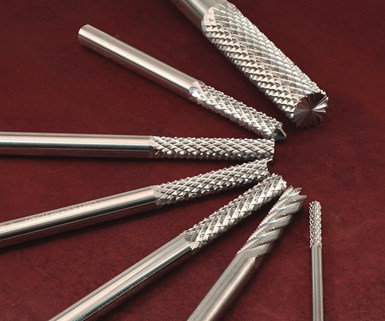YG-1's Fiberglass Routers Designed for Manual, CNC Cutting
YG-1 offers a series of four solid carbide fiberglass routers designed to handle machining of fiberglass and other high-performance fibers.
Share







YG-1 offers a series of four solid carbide fiberglass routers designed to handle machining of fiberglass and other high-performance fibers. These new routers are said to be optimized in composition, cutting angles, flute strength and stability for longer life and lower cost per part. Four different cutting ends make these fiberglass/composites routers ideal for roughing, finishing, edge trimming, slotting, grooving, drilling or interpolation, achieving the same quality results on a CNC machining center or hand routing, the company says.
The Type I (NC end) is mostly for side milling, roughing or finishing passes to achieve a high-quality finish. Type II (burr end) is designed for plunging without damaging side flutes. Type III (mill end) is best for surface milling molds or grooving with surface finish requirements. Type IV (drill end) can be used as a router and a drill and is designed for interpolation to achieve final hole diameter or slotting with a corner radius.
More applications include machining in carbon fiber, Kevlar and other aramid blends, natural fiber-based composites and thermoset resin/thermoplastic blends.
The tools’ double-angle point geometry is designed to counteract or eliminate the machining problems typically encountered with carbon fiber reinforced plastic (CFRP) characteristics. The CVD coating increases abrasion resistance from the fibrous materials and extends tool life. Combined with guidance margins and open flutes, these specialized routers also drill holes with no dust jams or pressure overload, the company says. Suited to manual hole-making, countersinks and counterbores, hand drilling reduces delamination and fiber pullout.
Related Content
-
Chuck Jaws Achieve 77% Weight Reduction Through 3D Printing
Alpha Precision Group (APG) has developed an innovative workholding design for faster spindle speeds through sinter-based additive manufacturing.
-
Custom Workholding Principles to Live By
Workholding solutions can take on infinite forms and all would be correct to some degree. Follow these tips to help optimize custom workholding solutions.
-
Lean Approach to Automated Machine Tending Delivers Quicker Paths to Success
Almost any shop can automate at least some of its production, even in low-volume, high-mix applications. The key to getting started is finding the simplest solutions that fit your requirements. It helps to work with an automation partner that understands your needs.











